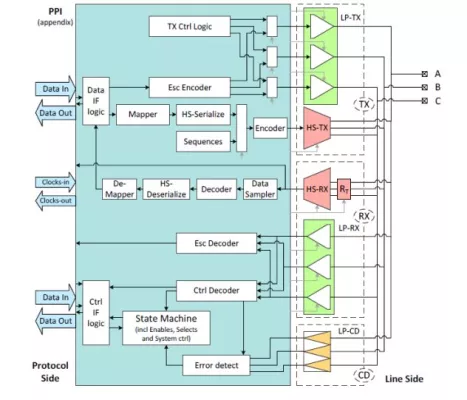The MIPI C-PHY is designed and compliant with latest MIPI C-Phy Standards.
The MIPI C-PHY V1.2 improves throughput over a bandwidth-limited channel, allowing more data without an increased signaling clock. It is intended to be used for the camera interface (CSI-2 v1.3) and display interface (DSI-2 v1.0). The signaling interface uses a 3-phase transceiver that encodes 3-bit symbols over 3 wires. This is different from the two-wire differential “lane” used in D-PHY.
C-PHY was designed to coexist on the same IC pins as D-PHY so that dual-mode devices could be developed with low power signaling similar to DPHY. Arasan’s CPHY-DPHY combination provides a 3 channel C-PHY v1.2 and a four-lane D-PHY v1.2 in a single IP core. This allows a seamless implementation allowing the interface to D-PHY based sensors or C-PHY based sensors.
Symbol encoding effectively transfers 2.286 bits per symbol compared to 1.0 bits per lane for D-PHY. The C-PHY (v1.2) operates at 3GS/s, whereas the D-PHY V1.2 (2.5Gb/s).
A four-lane D-PHY V1.2 provides 10Gbps which enables:
- 4K video at 30fps
- 1080p at 120fps
A 3 channel C-PHY provides 17Gbps which enables:
- 4K video at 60fps
- 1080p at 240fps (for cool slow-motion videos)
